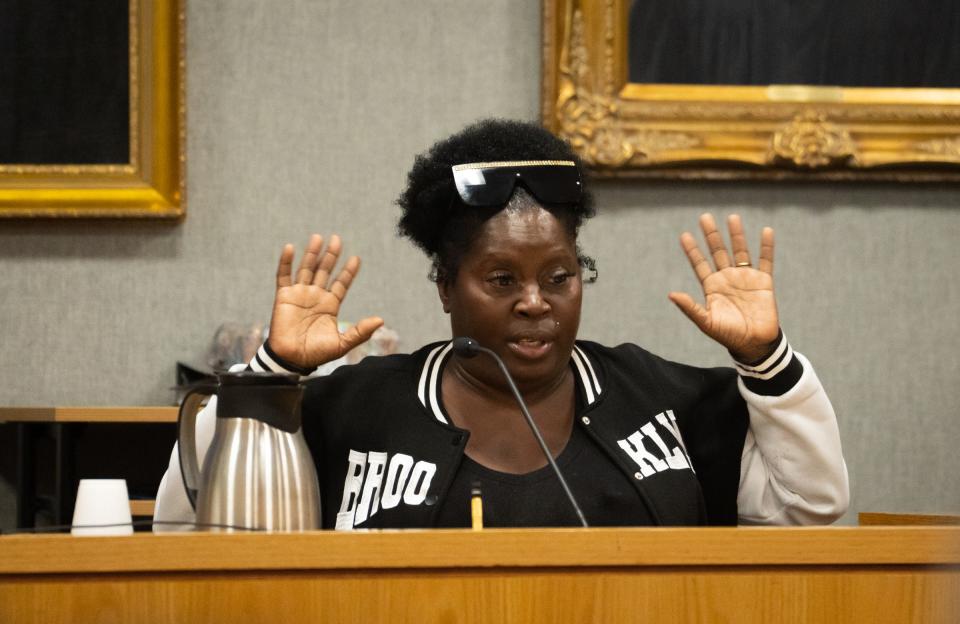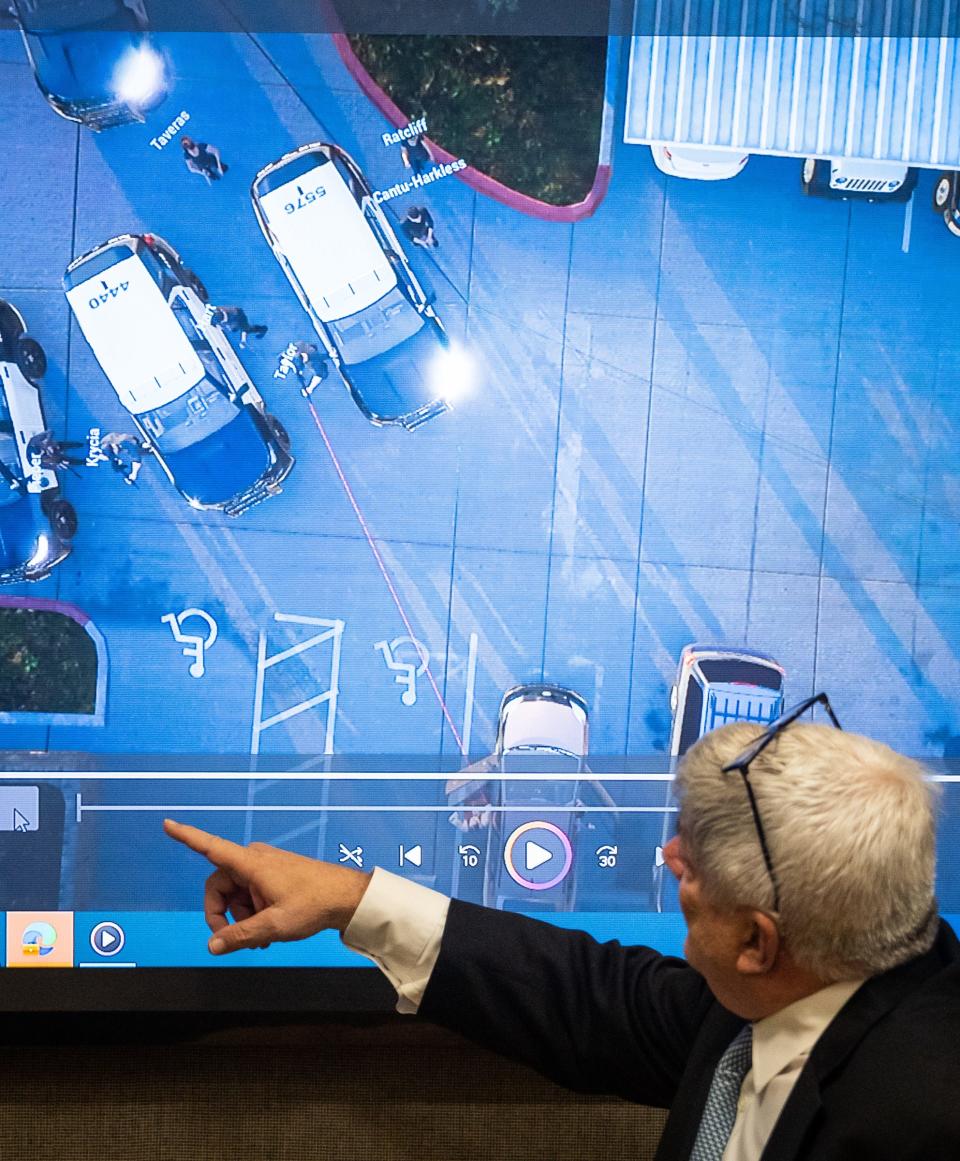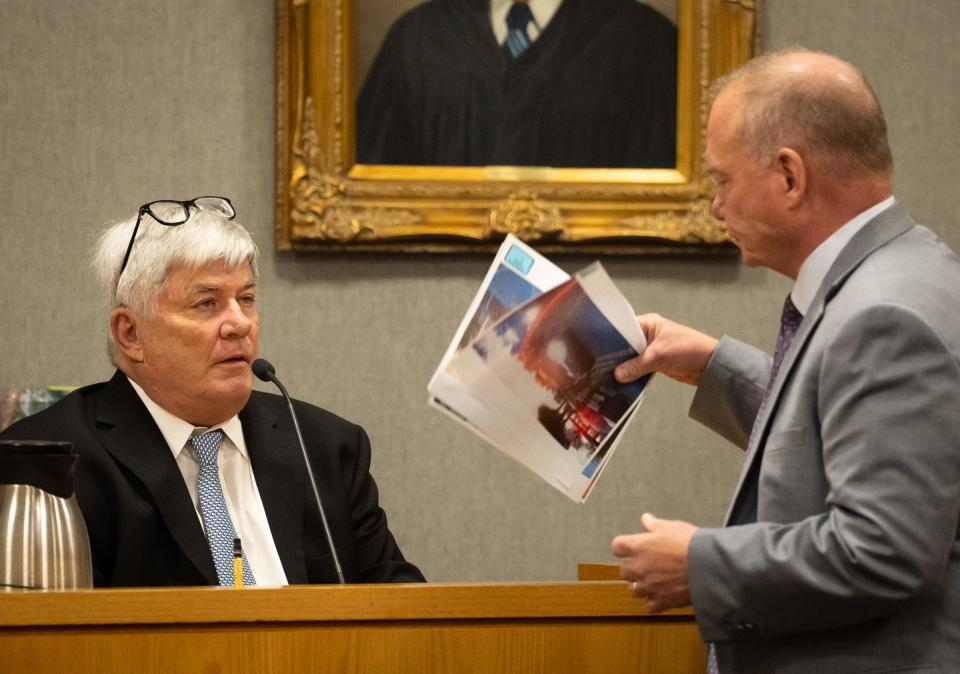'I feel like I shot him': 911 caller regrets inaccurate statement that Mike Ramos was armed
- Oops!Something went wrong.Please try again later.
In an emotionally charged revelation, the woman who made the 911 call that sent police to Michael Ramos’ location — an encounter that ended with Christopher Taylor shooting and killing him — said she felt responsible for his death.
“I feel like I shot him,” Meko Scott said in court Tuesday.
During the call, which played during her testimony, Scott repeatedly told the dispatcher that Ramos had a gun and said he had pointed it at the woman in the car with him, an allegation that Taylor’s attorneys have said shaped the police response. On the stand, Scott admitted that she never saw Ramos with a gun and was acting off what bystanders told her.
Police have confirmed no gun was ever found in Ramos’ vehicle or on the scene.
Scott repeatedly apologized to Ramos’ family in court.
Her comments came on the second day of testimony in Taylor’s murder trial, which also brought new details about the circumstances that led to Ramos’ death. Prosecutors presented an interactive digital rendering of the shooting and sparred with the defense over the implications of narcotics found in Ramos’ vehicle.

Taylor’s attorneys drew attention to narcotics found in Ramos’ vehicle
Prosecutors have openly acknowledged Ramos’ criminal history and have not shied away from presenting evidence with such implications. During the testimony of Sgt. Shelly Holmstrom — then an officer in the Special Investigations Unit — prosecutors displayed photos of illegal drugs and associated paraphernalia found in Ramos' car.
Holmstrom said that a white substance in one of the photos was likely crack cocaine.
In cross-examination, defense attorney Ken Ervin homed in on the presence of narcotics in the vehicle and their connection to Ramos’ behavior during the police encounter.
Ervin’s line of questioning suggested that being under the influence of narcotics such as crack cocaine might lead to erratic and aggressive behavior.
“Can (one of these substances) cause someone to become violent, when they would not have been violent but for this substance?” Ervin asked Holmstrom.Holmstrom agreed.
Ervin also suggested that narcotics could cause someone to be less sensitive to pain, which might have affected how Ramos reacted to being struck by a less-lethal round.
Assistant District Attorney Rob Drummond pushed back on Ervin’s assertions, saying that Holmstrom did not know what kind of drugs Ramos might have ingested, or in what quantity.

Prosecutors presented a digital rendering of shooting
Prosecutors presented an interactive 3D digital rendering, providing new vantage points on the shooting.
Mark Johnson, president and CEO of Visual Law Group, testified that his company used videos captured by police-worn body cameras, patrol vehicle dash cameras and bystander cellphone cameras. He described his process as “scientific.”
Prosecutors played animated videos that depicted the shooting from a bird’s-eye view, as well as from the perspectives of Ramos and Taylor.
Crucially, Johnson said his company was able to calculate the speed at which Ramos was driving when he was shot. He said that when the first shot was fired, Ramos was driving at 8.5 miles per hour.
Drummond also pointed out that at no point during the shooting was anyone in the path of Ramos’ vehicle.
Doug O’Connell, one of Taylor’s defense attorneys, questioned Johnson on his techniques and expertise. Gesturing at Taylor, O’Connell said, “You’re comfortable for this jury to rely on your work products, considering that Chris is on trial for murder?”
“Certainly,” Johnson replied.

911 caller apologized, saying that she never saw Ramos with a gun
In a pivotal moment, Scott took the stand to discuss the 911 call she made April 24, 2020.
Scott’s son lived in the Southeast Austin apartment complex where Ramos was killed.
At times crying, Scott described seeing Ramos in his vehicle that afternoon, doing what she thought was smoking narcotics. Scott said a group of bystanders had gathered around Ramos’ vehicle, and she was told that Ramos had been there “all day and all night.”
Scott said that an “older Hispanic woman” told her that Ramos had a gun, but she never saw one herself.
On the 911 call, Scott repeatedly told the dispatcher that Ramos had a gun.
She said that making the call was the “most messed-up mistake I’ve ever done.” But, throughout questioning from both prosecutors and defense attorneys, she insisted that the Hispanic woman — whom prosecutors said police were never able to locate — told her about the gun.
Assistant District Attorney Dexter Gilford pressed Scott on her claim about the Hispanic woman, but Scott held firm.
In his cross-examination, Ervin said, “I think it’s clear you had good intentions for why you did what you did, why you said what you said.”
He continued, “By now, you understand that your call set into motion a terrible chain of events.”
Ervin suggested that because Scott falsely claimed that she saw Ramos with a gun, police responded accordingly.
During Scott’s testimony, Brenda Ramos, Michael Ramos’ mother, left the courtroom in tears.
This article originally appeared on Austin American-Statesman: 911 caller testifies during Austin officer Christopher Taylor's trial

